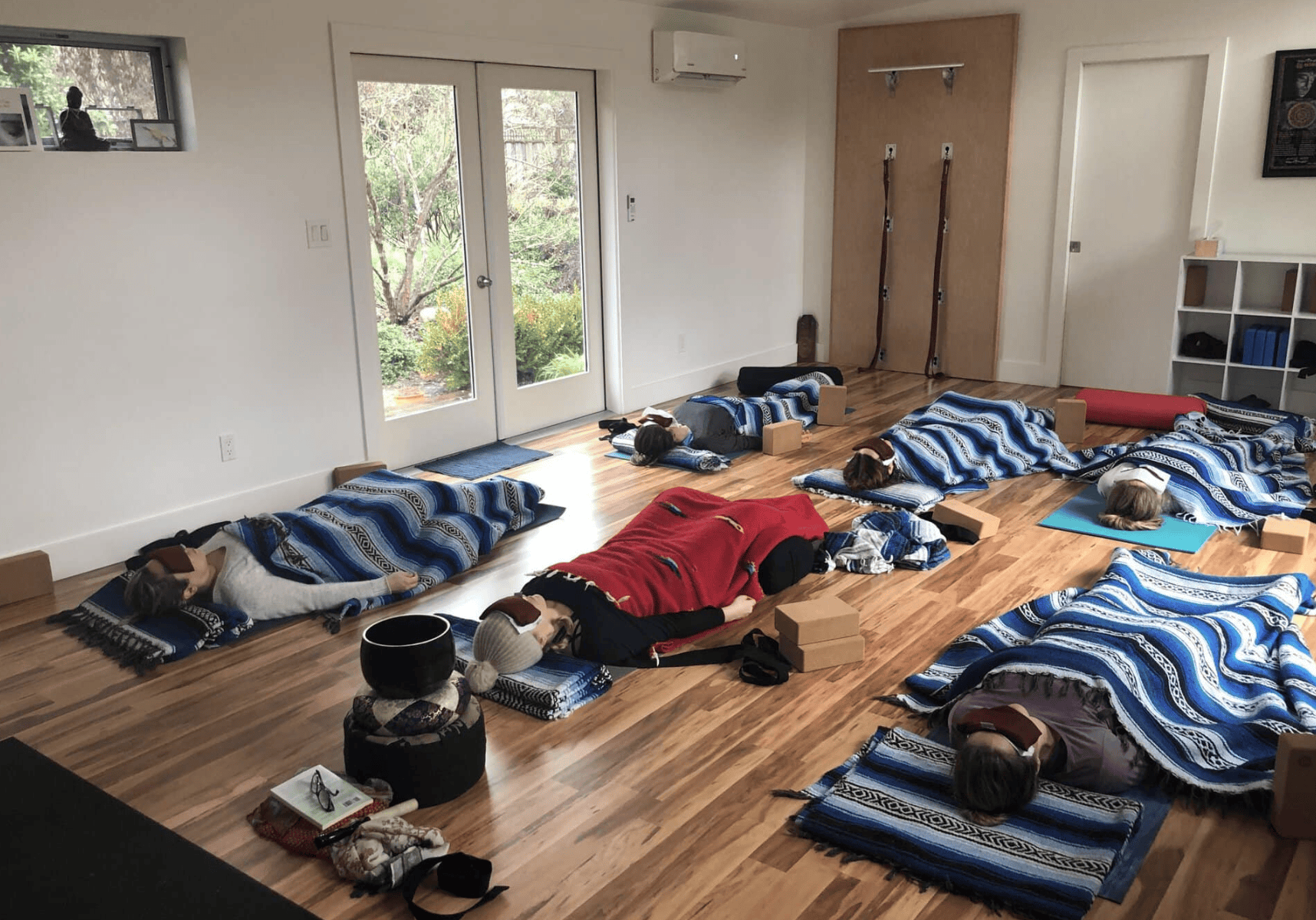
How Yoga Nidra Can Transform
Your Menopause Journey
Seven Ways Yoga Nidra can significantly support women during perimenopause and menopause - By Mellara Gold
Reading time: 4 minutes
Thankfully there has been a lot more in the news about Menopause and as we approach World Menopause Day on October 18th I can’t help but to feel excited and curious about how yoga plays an important role in supporting us women in this huge transition in life.
Especially Yoga Nidra as it is known for its therapeutic applications and promises to play a far greater role in the future as its potential becomes fully recognized by doctors, psychologists and healers; says Swami Satyananda Saraswati who is the author of Yoga Nidra that was first published in 1976.
Menopause self-care involves more than simply symptom management—it involves respecting our body and soul. A balanced diet, regular movement, and meditation are simple habits that can have a big impact on our well-being.
They can also help with stress reduction, hormone balance maintenance, and general health improvement. Furthermore, we can feel more connected to our inner self, which helps us get through this transitional period. A healthy emotional state is equally crucial throughout menopause. This time often makes us revaluate our lives, giving us a chance to think carefully about our own objectives and aspirations. And perhaps even letting go of things that no longer serve us, creating an opening for new blessings.
This time can also be looked as an opportunity to try different things that we have always wanted to, nurture our growth mindset and embrace support from our community. Yet speaking from experience as a 49 year old perimenopausal woman it can be hard to keep a good deal of inner motivation happening especially with all of the hormonal fluctuations. And our inner victim can easily kick in for a bit as we feel confused especially since we haven’t really been historically educated about menopause and/or sadly not always listened to from our doctors.
This is why I am personally working on embracing menopause as a sacred rite of passage that allows me to not just step into this new chapter with grace and confidence, but to feel its wisdom permeate through my whole being too. And perhaps even with a greater awareness than our own mothers and grandmothers were not afforded.
Menopause officially happens for us once we have not had our period for twelve months and one day. That’s it! And the years leading up to this one day in time is known as perimenopause, and that can last up to a decade. For my own menopause journey and not unlike a lot of us, we need to be our own best advocate, as most doctors, let alone OB/GYN residency programs are lacking to have a dedicated curriculum.
In the country that I live in, which is the U.S and according to a 2022 survey* published by The Menopause Society, only 31.3% reported having a residency program.
Most of those that do have a curriculum, the course is elective and doctors receive only 1-2 hours of education. Can you believe it? Seems crazy doesn’t it? Especially as we also seem to have a high cultural tolerance for women suffering. This along with little research being done on women’s health where we have also been sometimes considered as ‘little men’ feels outdated and rigid. Prioritizing half of our world’s population with more research, funding and compassionate integrative care feels essential.
I am heartened though by my birth country Australia, as it is being seen as a leader in the world of menopause. Dr. Mary Claire Haver a U.S based board-certified OB/GYN, and someone who I have learned so much; from her popular social media profiles, books and advocacy for women.
Dr. Haver believes that this will help Australia close the gender health gap in their country and also be an excellent blueprint for what can happen in every country. So there is a lot of hope!
And as we look deeper into Yoga Nidra we know it as a non-pharmacological technique that can help with sleep problems and other symptoms like anxiety and pain associated with menopause.
Yoga Nidra is a practice where we focus on being rather than doing, and it can almost feel as if it is the longest final rest (Savasana) you’ll ever do as it is performed laying on your back, eyes closed and generally for about 45 minutes. After practicing we can sometimes feel as if we had an extra three hours of sleep. Yet it is not there to replace our regular sleep, but it can help us rest more deeply in our nightly sleeping ritual.
It is because it is stimulating the parasympathetic nervous system. And in contrast to the sympathetic nervous system ("fight or flight") that is more directly linked to burning fat during high-energy situations like exercise. The parasympathetic nervous system ("rest and digest"), on the other hand, plays a supporting role by encouraging a relaxed state that allows for optimal digestion and metabolism, which can indirectly contribute to fat burning when combined with a healthy diet and exercise.
I have personally known this to be true inside my own body that is going through these symptoms and changes. If I haven’t been able to meditate or practice yoga nidra and at the same time I have been good about sympathetic exercises, like the traditional calorie burning exercises that we can do on a bike or walking, I will sometimes ironically have a bit of a cortisol belly. Which is a term used for weight gain around the abdomen that is caused by high levels of cortisol which is a hormone that our body makes when stress is present.
It feels unfair in the sense that the traditional ways in which we were able to find balance in our younger bodies certainly need to be tweaked and can look much different before we consciously enter into this unchartered chapter of our life. Of course this is not true for everybody as we are all thankfully unique and need to discover what works best for us.
This takes me back to my first experiences in Yoga Nidra. I had just turned 40 and was fortunate to discover this ancient practice. I don’t remember experiencing any huge hormonal symptoms back then, yet I did develop a frozen shoulder four years later that has been associated with estrogen deprivation. My Yoga teacher back then did mention to me that one of the best things that a woman can do in these years is to take up a yoga Nidra practice.
It’s funny though, I just kind of brushed his comment off for that moment, maybe because it didn’t feel as if it concerned me just yet, although now I understand through experience just how beneficial Yoga Nidra is for helping me to feel more grounded and accepting of this time in my life.
A regular practice of Yoga Nidra can significantly support women during perimenopause and menopause in the following ways:
1. Tension Reduction - By encouraging deep relaxation, it helps to lessen worry and tension, both of which can be exacerbated by hormone fluctuations.
2. Sleep Improvement - During menopause, a lot of women have trouble falling asleep. Yoga Nidra promotes deeper, more rejuvenating sleep by enhancing the quality of sleep.
3. Emotional Balance - By promoting emotional awareness and mindfulness, the practice aids in navigating mood swings and emotional changes.
4. Pain Relief - It can assist in easing the physical discomfort some women may feel, such as joint pain, frozen shoulder and headaches.
5. Body Awareness - Yoga Nidra helps people become more conscious of their bodies, which encourages acceptance and comprehension of the changes that come with this time of life.
6. Hormonal Regulation - Although indirect, the use of relaxation techniques can aid in maintaining hormonal balance and alleviate symptoms such as hot flashes. A comprehensive strategy for addressing the difficulties associated with perimenopause and menopause can be achieved by incorporating frequent Yoga Nidra practice.
7. Community and Support - Taking part in group classes can help women going through comparable struggles feel connected to one another and supportive of one another.







